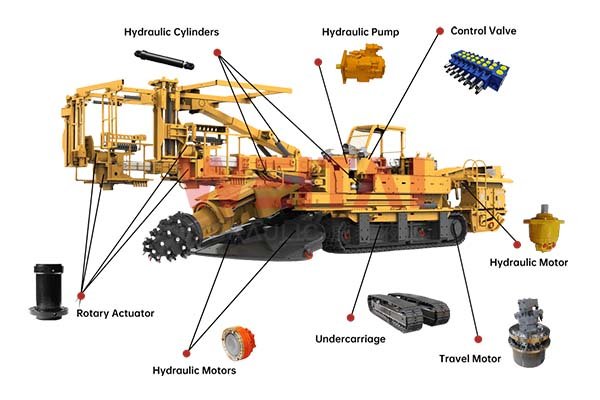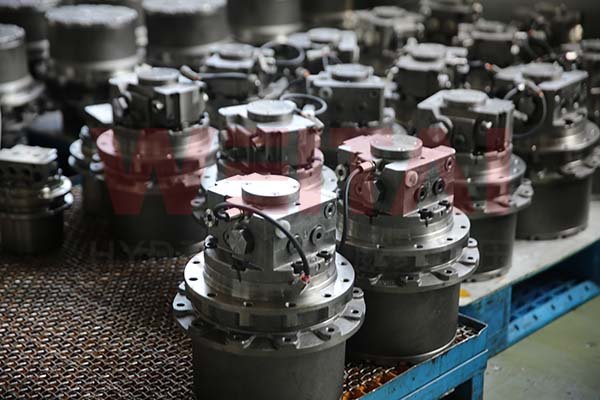Mobile hydraulic systems are an integral part of modern mobile machinery, providing the powerful, precise, and efficient control necessary for heavy-duty tasks in various industries. Unlike stationary hydraulic systems, which are fixed in industrial facilities or manufacturing plants, mobile hydraulics are designed to work within vehicles that move across different environments, such as construction sites, farms, mines, and roadways.
These systems are a key enabler of mobile equipment’s versatility, allowing machines to perform a wide range of tasks, from lifting and digging to steering and braking. Mobile hydraulics power everything from small attachments on tractors to the massive booms of cranes, making them indispensable to sectors like construction, agriculture, forestry, mining, and transportation.

Key Characteristics of Mobile Hydraulic Systems
Portability & Compact Design: Mobile hydraulic systems are engineered for integration into vehicles and machines where space is limited. They are designed to provide robust power without taking up excessive room, ensuring the mobility of the machinery isn’t compromised. Compact, yet powerful, mobile hydraulic components such as pumps, cylinders, and motors fit within the tight spaces available on machines like excavators, cranes, or trucks.
Power Source
These systems rely on the vehicle’s engine to drive a hydraulic pump, which converts mechanical energy into hydraulic pressure. The hydraulic fluid, typically oil, is pressurized and routed through a system of hoses and valves to perform various tasks, such as moving arms or actuators. In mobile machinery, the hydraulic pump often runs off the same engine that powers the vehicle’s movement, allowing the hydraulic system to function simultaneously with other machine operations.
Energy Efficiency
Mobile hydraulic systems need to be energy-efficient, as they often operate on limited power resources within the vehicle. For example, an excavator or crane needs to perform demanding tasks like lifting heavy loads without excessive fuel consumption or heat generation. Advanced hydraulic technology, such as load-sensing systems or variable displacement pumps, helps reduce power waste by adjusting the flow and pressure based on the demand, making the system more efficient.
High Power Density
A hallmark of mobile hydraulics is their high power-to-weight ratio. Despite their relatively compact size, these systems are capable of generating immense force. This is particularly important in heavy-duty applications where space is limited but substantial power is required, such as in lifting or pushing operations on construction equipment, or powering attachments like backhoes or graders on agricultural machines.
Durability & Adaptability
Mobile hydraulic systems are designed to be rugged and durable, able to withstand harsh working conditions like extreme temperatures, dust, dirt, and moisture. This robustness ensures that equipment can operate reliably in demanding environments such as construction sites or agricultural fields. Furthermore, mobile hydraulics must be adaptable to varying workloads and terrains, ensuring they maintain performance whether the vehicle is stationary or in motion.
Precise Control & Flexibility
One of the standout advantages of mobile hydraulic systems is their ability to provide precise, smooth control over mechanical movements. Whether it’s raising a crane’s boom, digging with an excavator’s bucket, or steering a large piece of agricultural equipment, hydraulics offer fine control over speed, direction, and force, allowing operators to perform complex tasks with ease. Hydraulic circuits can also be customized for specific functions, providing flexibility in controlling multiple machine operations with the same system.
Key Components of a Mobile Hydraulic System
Hydraulic Pump: Converts mechanical energy into hydraulic energy by moving hydraulic fluid under pressure.
Hydraulic Cylinders: Extend and retract to move components like booms or arms.
Hydraulic Final Drive Motors: Provide rotary motion to move parts like tracks, wheels, or augers.
Valves: Control the flow of hydraulic fluid and direct it to different parts of the system.
Hydraulic Fluid: Transfers power within the system, providing lubrication and cooling as well.
Filters: Keep the fluid clean to ensure the system runs efficiently without contamination.
Examples of Mobile Hydraulic Applications
Excavators: The hydraulic system powers the boom, dipper, and bucket to perform digging and lifting tasks. It also allows the cab to rotate, providing 360-degree mobility.
Cranes: In cranes, hydraulics enable the precise lifting, lowering, and rotation of heavy loads. The hydraulic system powers both the extension of the crane’s boom and its movement, making it an essential component for construction and industrial applications.
Tractors: Agricultural tractors rely on hydraulic systems to operate attachments like plows, mowers, and seeders. The hydraulics provide the force needed to lift, lower, and move these implements, as well as control various machine functions, including steering and braking.
Dump Trucks: A critical part of dump trucks is the hydraulic cylinder that raises and lowers the bed, enabling the efficient unloading of material. Without hydraulics, these tasks would be inefficient and physically demanding.
Skid Steer Loaders: Compact and versatile, skid steers use hydraulics to power their arms and attachments, allowing them to dig, lift, or transport materials in confined spaces.
Forestry Equipment: Hydraulic-powered grapples, saws, and winches allow forestry equipment to fell trees, load logs, and perform other heavy-duty tasks in rugged environments.
Mining Equipment: Heavy mobile mining machinery, like drills and rock breakers, depends on hydraulics to generate the force needed to cut through hard rock and move debris.
Why Mobile Hydraulics Matter
Mobile hydraulic systems are at the heart of modern machinery efficiency and functionality. Their ability to provide high-power output in compact, reliable, and energy-efficient packages makes them indispensable for industries that require machinery capable of performing multiple, high-stress tasks in ever-changing environments. Whether it’s for lifting, digging, steering, or any other operation, mobile hydraulics are what keep modern construction, agricultural, and mining equipment working effectively on the move.



